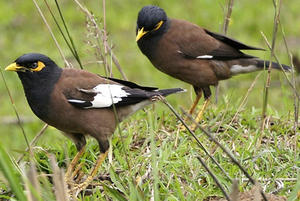Cold war offered odd benefit: it limited species invasions
During the cold war, when an Iron Curtain divided the European continent, there were few introduced bird species in Western Europe; following the collapse of the Soviet Union and the removal of the Iron Curtain, trade and the movement of people between east and west increased – and with it the introduction of non-native bird species; these non-native species do not have natural enemies in the local habitat, so they do damage to agriculture and domestic birds, and carry disease

Invaders from the East - the Common Myna // Source: avianweb.com
A recent study about movement of bird species during the cold ear outlines one of the perils facing an expanding global economy — along with international trade comes the potential for a significant increase in invasive species that can disrupt ecosystems.
The research found that during an extended period following the Second World War, when most trade and travel was interrupted between Eastern Europe and its Western counterparts, there were far fewer introduced bird species.
“Last year, people worldwide celebrated the twentieth anniversary of the fall of the Iron Curtain and the end of the cold war,” said Susan Shirley, a research associate in the College of Forestry at Oregon State University. “This signified a time of renewed freedom and opportunities for the countries of Eastern Europe. However, those new opportunities brought new challenges from an unexpected source.”
The problem, Shirley said, is that there is often a correlation between politics, trade and ecosystem function. “Global trade is a real concern for invasive species, and the lessons we can learn from the Cold War offer a warning flag to developing countries that are now expanding in an international economy,” Shirley said.
Control or eradication of invading species is extremely difficult and expensive, Shirley said, and prevention of animal importation is the only sure approach to address this problem. It relates not just to birds, which were the focus of this research, but to forest pests, fisheries, non-native crustaceans and many other species.
Even though birds, in theory, need pay little attention to international borders, in fact they tend to stay in native habitats. They sometimes establish populations in new locales, however, if they are brought there, Shirley said. “Traditionally we don’t hear much about birds as an invasive species, but they can be,” she said. “The common myna, a subtropical bird, is a generalist predator and a crop pest, and has been included on a list of the 100 worst invasive species,” Shirley said. “The collard dove is a habitat generalist and has now spread all over Europe. And of even more concern, there are several species with serious impacts in other regions of the world that may be in the process of establishing populations in Europe, largely due to the escape of wild-caught pet birds.”
The study, published recently in the journal Biological Conservation, found that prior to the cold war, Western Europe had thirty-six non-European introduced species and Eastern Europe had eleven. By the time that period of international tension and restricted trade ended, Western Europe had experienced an increase to fifty-four non-European introduced bird species, but Eastern Europe had actually declined from eleven to five.
“The isolation of the Eastern European bloc from the West during the cold war led to a decline in the number of birds introduced, the number of introduction events and the number of bird species established,” the study authors wrote in their report.
In light of that, the researchers suggest that clear policies need to be established to prevent further inflow of exotic species into previously isolated regions, and warn that the problems illustrated by this phenomenon in Europe may play out in similar ways all over the world as trade expands.
The unusual isolation of Eastern Europe for more than four decades provided a unique opportunity to study the effect of socio-economic and political factors on invasive species, the researchers said. In that context, eastern European ecosystems actually benefited from the isolation, scientists said, and also provide insight into how invasive species problems can be reduced with more aggressive regulation and monitoring.
